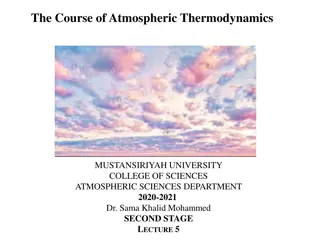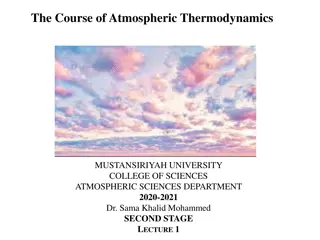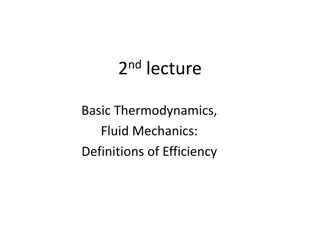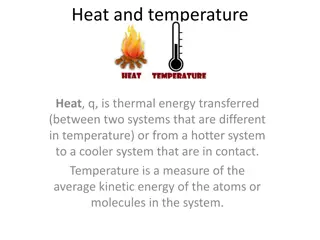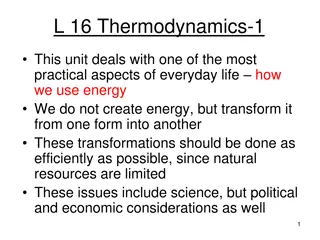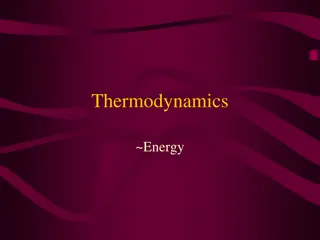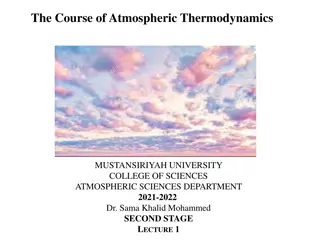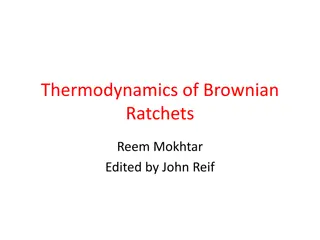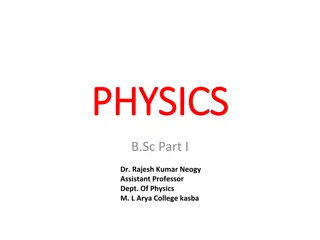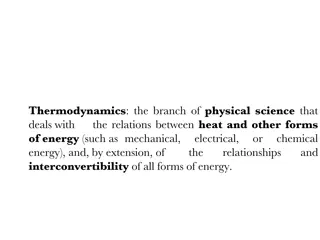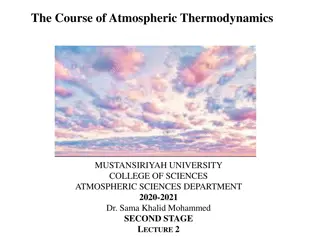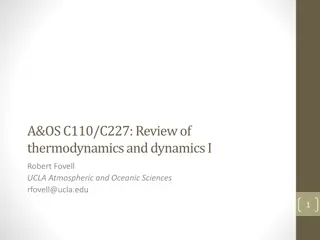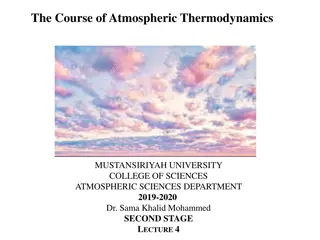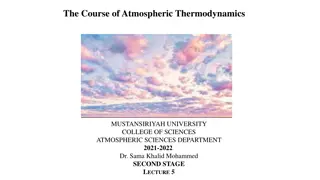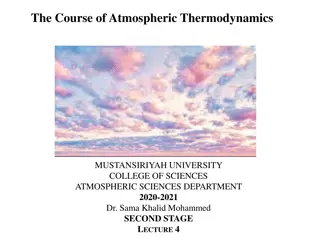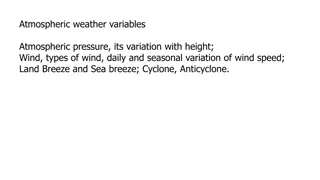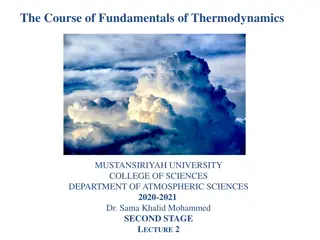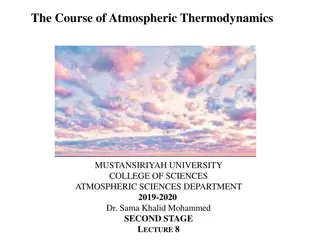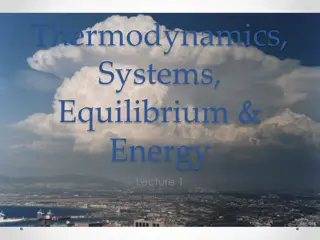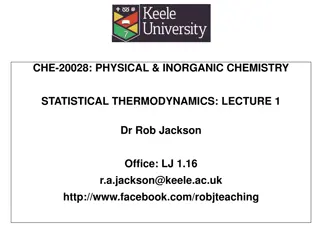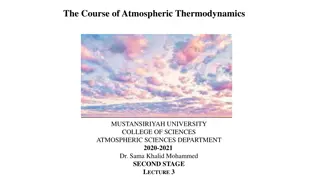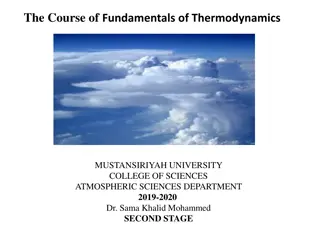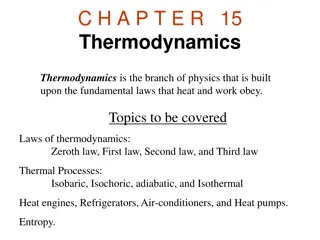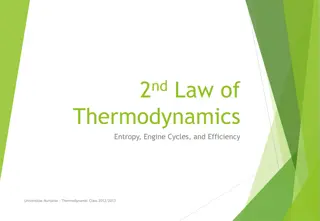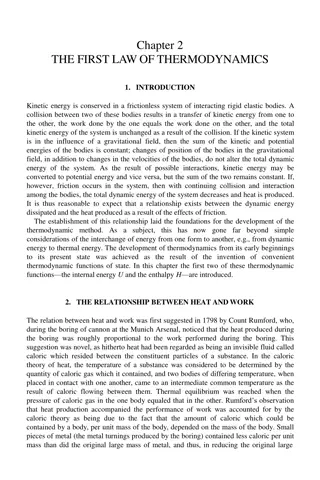Atmospheric Thermodynamics in Second Stage Lecture
Explore key concepts in atmospheric thermodynamics, including condensation level, free convection level, and the use of thermodynamic diagrams. Learn about the process of condensation, stability levels in the atmosphere, and the significance of free convection in weather patterns. Discover why therm
0 views • 27 slides
Geopotential and Geopotential Height in Atmospheric Thermodynamics
Explore the concept of geopotential and geopotential height in atmospheric sciences, focusing on their significance in understanding gravitational and centrifugal forces on Earth. Learn about the definition, calculation, and applications of geopotential height in relation to atmospheric properties a
1 views • 14 slides
Thermodynamics and Fluid Mechanics Fundamentals for Efficiency
Explore key concepts in thermodynamics and fluid mechanics such as the equation of continuity, the first law of thermodynamics, the momentum equation, Euler's equation, and more. Learn about efficiency, internal energy, and the laws governing energy transfer in various systems. Delve into topics lik
2 views • 12 slides
Heat and Temperature in Thermodynamics
Thermal energy transfer, heat, and temperature play crucial roles in determining the behavior of systems in terms of kinetic energy and molecular motion. The zeroth law of thermodynamics establishes the relationship between heat and temperature. Heat transfer leads to changes in the average kinetic
8 views • 8 slides
Atmospheric Pressure Variations at Different Altitudes
Atmospheric pressure varies with altitude due to the weight of the air column above. This activity explores how Otto von Guericke's experiments with vacuum systems demonstrate the power of air pressure. Theoretical concepts of atmospheric pressure are discussed, highlighting its relation to gravity
1 views • 28 slides
Thermodynamics and Energy Transformation
Thermodynamics is a crucial unit that deals with how energy is transformed from one form to another efficiently. This field is essential for managing energy resources sustainably and covers topics such as temperature, heat, internal energy, and applications in various systems. Learn the basics of th
1 views • 22 slides
Thermodynamics: Energy and Heat
Explore the fundamental concepts of thermodynamics, including the conservation of energy, entropy, heat transfer, and the relationship between temperature and kinetic energy. Discover how energy transforms in natural events, the laws governing thermodynamics, and the role of heat in the motion of pa
1 views • 28 slides
Cutting-Edge Atmospheric Chemistry Modeling Research at Barcelona Supercomputing Center
Conducted by the Atmospheric Composition Group at Barcelona Supercomputing Center, this cutting-edge research focuses on atmospheric chemistry modeling using advanced tools and frameworks like HERMESv3 and MONARCH. The team's approach integrates various modules to study complex processes influencing
0 views • 16 slides
Geopotential and Geopotential Height in Atmospheric Thermodynamics
This lecture discusses the concepts of geopotential and geopotential height in atmospheric thermodynamics, including their definitions, significance, and relationship with gravity. It explains how geopotential is a measure of potential energy relative to sea level and how geopotential height serves
0 views • 17 slides
Kinetic Theory of Gases and Thermodynamics
Explore the fundamental principles of the kinetic theory of gases, including the five postulates and the relationship between macroscopic properties and microscopic phenomena. Delve into the concept of entropy and thermodynamics, along with the behavior of ideal and real gases. Gain insights into th
0 views • 116 slides
Exploration of Thermodynamics in SU(3) Gauge Theory Using Gradient Flow
Investigate the thermodynamics of SU(3) gauge theory through gradient flow, discussing energy-momentum stress pressure, Noether current, and the restoration of translational symmetry. The study delves into lattice regularization, equivalence in continuum theory, and measurements of bulk thermodynami
0 views • 40 slides
Thermodynamics: Laws and Maxwell's Demon
Explore the laws of thermodynamics including the first, second, and third laws, and Maxwell's Demon thought experiment challenging the second law. Learn how entropy and energy are fundamental concepts in thermodynamics.
1 views • 18 slides
Introduction to Thermodynamics: Laws, Concepts, and Applications
Thermodynamics is the study of energy and its transformations within systems. This article delves into the laws of thermodynamics, defining key quantities like temperature and entropy. It explains the importance of thermodynamic systems, boundaries, and surroundings, highlighting closed, open, and i
2 views • 12 slides
Horizon Thermodynamics of Lovelock Black Holes by David Kubiz
Gravitational dynamics and thermodynamics in Lovelock black holes are explored in this talk, discussing free energy, universal thermodynamic behavior, Lovelock gravity, and beyond spherical symmetry. References include works on black hole thermodynamics, local Rindler horizons, and apparent horizons
1 views • 25 slides
Basics of Thermodynamics and Energy Principles
Explores fundamental concepts in thermodynamics, including energy, the first law of thermodynamics, heat vs. temperature, system vs. surroundings, direction of heat flow, thermal equilibrium, exothermic vs. endothermic processes, and units of energy. Learn about energy conversions, conservation, and
1 views • 24 slides
Thermodynamics: The Science of Energy Relations
Thermodynamics is a branch of physical science that focuses on the relationships between heat and various forms of energy, exploring the interconvertibility of energy types. It involves the study of systems, surroundings, phases, components, and reactions, with a primary focus on macroscopic energie
1 views • 99 slides
Atmospheric Thermodynamics in Meteorology
Explore the fundamentals of atmospheric thermodynamics including dry air properties, dry adiabatic lapse rate, moist air components, and saturated adiabatic lapse rate. Delve into concepts like dew point temperature, relative humidity, and wet bulb temperature to gain insight into air behavior in va
1 views • 22 slides
Atmospheric Composition and Structure
The presentation covers fundamental concepts related to the Earth's atmosphere, including its composition, origin of oxygen, dry and moist layers, standard atmosphere layers, and temperature variations. Key topics discussed include the primordial atmosphere, atmospheric constituents, water vapor dis
0 views • 58 slides
Atmospheric Thermodynamics and Humidity Measurements
Explore the key concepts of atmospheric thermodynamics including wet bulb temperature, wet bulb depression, dew-point temperature, and relative humidity. Learn how meteorologists use psychrometric charts to measure humidity and analyze air moisture content. Discover the significance of wet bulb depr
1 views • 20 slides
Atmospheric Thermodynamics and Environmental Lapse Rate
Explore the concepts of atmospheric thermodynamics including the Parcel Method, Environmental Lapse Rate, and Conditionally Unstable Atmosphere. Dive into the details of how air parcels behave in different atmospheric conditions and understand the significance of temperature changes in the atmospher
0 views • 27 slides
Atmospheric Thermodynamics: Key Concepts and Applications
Exploring the principles of atmospheric thermodynamics in a lecture by Dr. Sama Khalid Mohammed at Mustansiriya University. Topics covered include air parcel behavior, relative humidity definitions, and factors affecting humidity levels. Gain insights into saturation, supersaturation, and how temper
1 views • 22 slides
Heat Transfer in Engineering Systems
Exploring the fundamental concepts of heat transfer and thermodynamics, this collection of images and explanations delves into the processes governing temperature change, energy transfer, and the analysis of systems based on the conservation of energy. From distinguishing between heat transfer and t
0 views • 16 slides
Atmospheric Pressure, Wind Variations, and Humidity in Weather Systems
The atmosphere is composed of various elements like gaseous molecules, water vapor, and dust particles. Key weather variables include atmospheric pressure, temperature, humidity, wind, cloud cover, and precipitation. Atmospheric pressure is influenced by the weight of air above a point, with average
1 views • 17 slides
The Fundamentals of Thermodynamics in Atmospheric Sciences
Explore the key concepts of thermodynamics in atmospheric sciences as discussed in the second stage lecture, covering topics such as extensive versus intensive variables, reversible and irreversible processes, cyclic processes, and thermodynamic variables. Gain insights into properties of systems, w
1 views • 22 slides
The Course of Atmospheric Thermodynamics
The lines on a SKEW T-LOG P diagram play a crucial role in understanding atmospheric thermodynamics. These lines include isotherms, dry adiabats, and moist adiabats, each representing different properties of the atmosphere. By outlining and defining these lines, one can gain insights into temperatur
0 views • 24 slides
The Course of Atmospheric Thermodynamics at Mustansiriya University
Atmospheric thermodynamics explores the properties of moist air, including partial pressure, vapor pressure, specific humidity, and more. Learn about the key concepts in this second-stage lecture led by Dr. Sama Khalid Mohammed at Mustansiriya University College of Sciences. Understand the relations
0 views • 17 slides
Future Changes in Atmospheric Rivers in Norway
Research investigates future trends in atmospheric rivers and extreme precipitation in Norway. Findings show increasing frequency and intensity of atmospheric rivers in the Far-Future, particularly during summer, with winter precipitation rising on the mid- and south-west coasts. Utilizing data obse
0 views • 13 slides
Atmospheric Sciences 101 Atmospheric Sciences 101
Dive into the fascinating world of atmospheric sciences with this comprehensive course. Learn to interpret weather maps, satellite imagery, and radar data. Explore key atmospheric phenomena and their relation to physical principles and laws. Discover how to be a savvy weather consumer by understandi
0 views • 10 slides
Thermodynamics and Energy Concepts
This content covers essential topics in thermodynamics and energy, including thermochemistry, laws of thermodynamics, energy terminology, kinetic and potential energy, energy and temperature relationships, thermodynamic systems, and the zeroth and first laws of thermodynamics. It explores the behavi
1 views • 23 slides
Understanding Thermodynamics and Energy Transformations in Geochemistry
This lecture introduces the fundamental concepts of thermodynamics, systems, equilibrium, and energy transformations in geochemistry. It covers the application of thermodynamics to predict equilibrium states, reactions, and mineral formation in geological processes. The course outlines the study of
0 views • 22 slides
Understanding Atmospheric Sciences Course: Winter 2023
Gain an understanding of synoptic systems, dynamical concepts, and weather forecasting in the Atmospheric Sciences 370 course for Winter 2023 with Cliff Mass and Rick Steed. Explore the structure and evolution of weather phenomena, developing essential skills in atmospheric analysis and forecasting
0 views • 6 slides
Exploring Statistical Thermodynamics in Physical Chemistry
Discover the fascinating world of statistical thermodynamics in physical chemistry, bridging the gap between macroscopic thermodynamics, kinetics, and microscopic atomic structures explained by quantum mechanics. Delve into topics such as the Boltzmann Distribution, partition functions, and the link
0 views • 26 slides
Atmospheric Thermodynamics Lecture: Virtual Temperature and Wet Bulb Concepts
Explore the key concepts of virtual temperature and wet bulb temperature in atmospheric thermodynamics. Learn about the virtual temperature as a measure of moisture content in moist air and the significance of wet bulb temperature in humidity measurement. Dive into the relationships between these pa
0 views • 19 slides
Fundamentals of Thermodynamics at Mustansiriya University
Explore the principles of thermodynamics in this comprehensive course at Mustansiriya University's College of Sciences. Topics covered include systems, energy transformations, atmospheric thermodynamics, and definitions related to thermodynamic processes.
0 views • 27 slides
Understanding Thermodynamics: Laws, Processes, and Applications
Explore the key concepts of thermodynamics, including the laws of thermodynamics, thermal processes, systems and surroundings, diathermal versus adiabatic walls, and the zeroth and first laws of thermodynamics. Gain insights into the fundamental principles governing heat, work, and energy transforma
0 views • 12 slides
Thermodynamics Concepts and Perfect Gas Introduction at Universitas Nurtanio
Explore the fundamental concepts of thermodynamics, including entropy, engine cycles, and efficiency at Universitas Nurtanio. Learn about perfect gases and their properties, ideal gas state equation, internal energy, and enthalpy. Dive into examples and applications to deepen your understanding. Get
0 views • 57 slides
Introduction to Thermodynamics: Laws of Energy Conservation
Explore the foundational concepts of thermodynamics, focusing on the conservation of kinetic and potential energies in systems, the relationship between heat and work, and the historical evolution of understanding in the field. Learn about the first law of thermodynamics, the role of internal energy
0 views • 24 slides
Fundamentals of Thermodynamics Lecture Summary
Explore the foundational concepts of thermodynamics in this lecture series, covering processes like isolated, cyclic, isothermal, isochoric, isobaric, and adiabatic processes. Gain insights into the first law of thermodynamics and key properties of different thermodynamic processes. Dive into the sp
0 views • 24 slides
Understanding Phase Change in Atmospheric Thermodynamics
Explore the concept of phase change in atmospheric thermodynamics, including the transitions between solid, liquid, and vapor states, the critical point, and unique characteristics of water's phases. Discover how heat energy is involved in these transformations and the impact on the environment.
0 views • 29 slides
Understanding Atmospheric Thermodynamics and Heat Engine Efficiency
Explore the concepts of the Second Law of Thermodynamics, the Carnot Cycle, and the relevance of heat-engine efficiency in atmospheric processes such as tropical cyclones and monsoons. Discover how these processes can be viewed as heat engines operating between temperature reservoirs.
0 views • 12 slides
